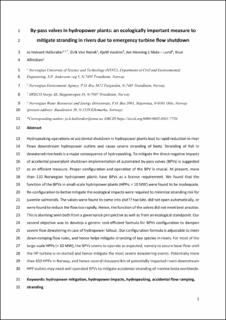| dc.contributor.author | Halleraker, Jo Halvard | |
| dc.contributor.author | Natvik, Eirik Vee | |
| dc.contributor.author | Vaskinn, Kjetil Arne | |
| dc.contributor.author | L´Abée-Lund, Jan Henning | |
| dc.contributor.author | Alfredsen, Knut Tore | |
| dc.date.accessioned | 2023-03-17T08:25:29Z | |
| dc.date.available | 2023-03-17T08:25:29Z | |
| dc.date.created | 2023-02-08T08:20:05Z | |
| dc.date.issued | 2023 | |
| dc.identifier.citation | Rivers Research and Applications: an international journal devoted to river research and management. 2023, . | en_US |
| dc.identifier.issn | 1535-1459 | |
| dc.identifier.uri | https://hdl.handle.net/11250/3058924 | |
| dc.description.abstract | Hydropeaking operations or accidental shutdown in hydropower (HP) plants lead to rapid reduction in river flows downstream HP outlets and cause severe stranding of biota. Stranding of fish in dewatered riverbeds is a major consequence of hydropeak- ing. To mitigate the direct negative impacts of accidental powerplant shutdown implementation of automated by-pass valves (BPVs) is suggested as an efficient mea- sure. Proper configuration and operation of the BPV is crucial. At present, more than 110 Norwegian HP plants have BPVs as a license requirement. We found that the function of the BPVs in small-scale HP plants (HPPs <10 MW) were found to be inadequate. Re-configuration to better mitigate the ecological impacts were required to minimize stranding risk for juvenile salmonids. The valves were found to come into operation too late, did not open automatically, or were found to reduce the flow too rapidly. Hence, the function of the valves did not meet best practice. This is alarming seen both from a governance perspective as well as from an ecological standpoint. Our second objective was to develop a generic cost-efficient formula for BPVs con- figuration to dampen severe flow dewatering in case of HP fallout. Our configuration formula is adjustable to meet down-ramping flow rules, and hence may helps to miti- gate stranding of key species in rivers. For most of the large-scale HPPs (>10 MW), the BPVs seems to operate as expected, namely to secure base-flow until the HP tur- bine is re-started and hence mitigate the most severe dewatering events. Potentially more than 650 HPPs in Norway, and hence several thousand of river km downstream HPP outlets may need well-operated BPVs to mitigate accidental stranding of river- ine biota worldwide. | en_US |
| dc.description.abstract | By-pass valves in hydropower plants: An ecologically important measure to mitigate stranding in rivers due to emergency turbine flow shutdown | en_US |
| dc.language.iso | eng | en_US |
| dc.rights | Navngivelse 4.0 Internasjonal | * |
| dc.rights.uri | http://creativecommons.org/licenses/by/4.0/deed.no | * |
| dc.title | By-pass valves in hydropower plants: An ecologically important measure to mitigate stranding in rivers due to emergency turbine flow shutdown | en_US |
| dc.title.alternative | By-pass valves in hydropower plants: An ecologically important measure to mitigate stranding in rivers due to emergency turbine flow shutdown | en_US |
| dc.type | Journal article | en_US |
| dc.type | Peer reviewed | en_US |
| dc.description.version | acceptedVersion | en_US |
| dc.source.pagenumber | 14 | en_US |
| dc.source.journal | Rivers Research and Applications: an international journal devoted to river research and management | en_US |
| dc.identifier.doi | 10.1002/rra.4113 | |
| dc.identifier.cristin | 2123984 | |
| dc.relation.project | Norges forskningsråd: 289725 | en_US |
| cristin.ispublished | true | |
| cristin.fulltext | postprint | |
| cristin.qualitycode | 1 | |

